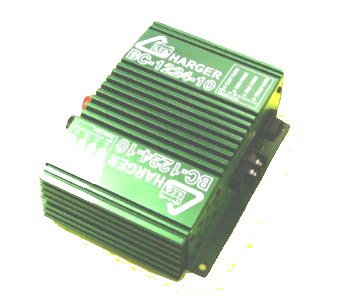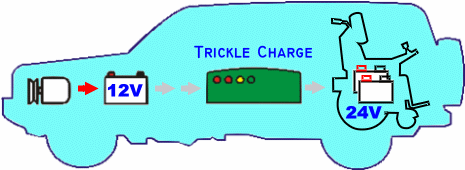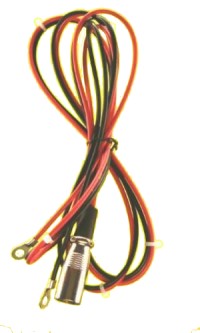|
| Model Number |
PST-BC1224-10 |
| Input Voltage Range |
10 VDC to 15 VDC |
| Input Current requirements |
12 Amps peak |
| Battery Voltage |
24 Volt nominal, 29.4 volt peak |
| Peak Output Power |
280 W |
| Peak Charging Current |
5 amps |
| Typical Charging Current |
4 amps |
| Charge current options |
The peak charge current can be adjusted to
1-5 amps by internal trim pots VR2 (turn counterclockwise to lower the current)
and VR1 (if you can't get low enough with VR2). |
| Charging Method |
4 stage charging Trickle-Bulk-Over-Float for
fast but safe charging
Click here to view the
state diagram |
| Battery Size |
5 AH to 200+ AH |
| No-Load Overhead |
150 mA |
| Quiescent Current |
80mA when the output is not connected to a
battery |
| Efficiency |
>85% |
| Isolation |
Non-isolated, the negatives are common on
the input and output |
| Fuse |
Front panel fuse protects the customer's
wiring from overcurrent events |
| Protection |
Polarity, Short Circuit, Input Reverse
Voltage, Over Temperature |
| Indicators |
Front Panel LEDS Indicate DC Power Input,
Alarm buzzer, and Charging Stage |
| Dimensions |
200 x 164 x 67 mm
7.9 x 6.7 x 2.8
inches
Click Here for a Dimensioned Drawing.
|
| Weight |
1.5 kg |
The following table describes the display of
LED lights at different stages of charging:
| Status |
Completion |
Red LED 1 |
Red LED 2 |
Yellow LED |
Green LED |
| Standby |
|
LEDs cycle while waiting |
| Trickle before bulk charge |
0-10% |
The two red LEDs cycle
(alternating) |
Off |
Off |
| Bulk charge |
10-90% |
Off |
Red 2 and yellow cycle
(alternating) |
Off |
| Fill charge (also known as "over charge") |
90-99% |
|
|
Yellow and green cycle
(alternating) |
| Float charge |
100% |
|
|
|
Green flash |
| Low battery voltage alarm |
|
Flash |
Off |
Off |
Off |
| High battery voltage alarm |
|
Off |
Flash |
Off |
Off |
| Low input voltage alarm |
|
Flash |
Off |
On |
Off |
| High input voltage alarm |
|
Off |
Flash |
On |
Off |
| Over temperature alarm |
|
Off |
Off |
Flash |
Off |
Q: Can I leave the battery continuously on the
charger?
A: Yes, the charger will go into "maintenance mode" and keep
the battery topped off.
Q: Can I draw power from the battery when the
charger is connected?
A: Probably. . . There is some pulsing going on
with the charger which your equipment might not be happy with (it is a
pulse-charger, 1 second pulses with 20mS gaps), but if you combine this with
the battery the battery will fill in the gaps, so the ripple is no more than it
would see in an automotive application.
Q: If I discharge the battery
while the charger is attached will the charger maintain a full
charge?
A: Yes, When the charger detects that the battery voltage has
dropped it knows that the battery needs to be charged and goes into "bulk
charge" mode again automatically.
Q: Can the charger be left connected to
the battery when the charger is not turned on, or when the input voltage of the
charger has been cut off?
A: Yes.
Q: Can the charger be adjusted
to lower currents?
A: Yes.
There are two trimpots that we can adjust here or click here to view the
instructions
Applications:
 Charging wheel chairs, bicycles, and scooters in a car, van or bus.
Charging wheel chairs, bicycles, and scooters in a car, van or bus.
 Microprocessor controlled 4 stage adaptive charging algorithm suitable for
Gel, Absorbed Glass Mat, VRLA, or flooded lead acid batteries.
Microprocessor controlled 4 stage adaptive charging algorithm suitable for
Gel, Absorbed Glass Mat, VRLA, or flooded lead acid batteries.
 Fully automatic without intervention.
Fully automatic without intervention.
 Output short circuit and battery polarity protections. Input low voltage and
high voltage connections.
Output short circuit and battery polarity protections. Input low voltage and
high voltage connections.
 Charging 24 volt batteries from a vehicle.
Charging 24 volt batteries from a vehicle.
 Charging 24 volt "jump start" batteries from a 12 volt tow truck or service
vehicle.
Charging 24 volt "jump start" batteries from a 12 volt tow truck or service
vehicle.
 Charging 24 volt electric bicycle from a vehicle.
Charging 24 volt electric bicycle from a vehicle.
 Four stage charge--constant current, constant voltage, fill, and float. This
charges your battery the fastest way possible without damaging the battery. It
is suitable for any size 24 volt lead acid battery.
Four stage charge--constant current, constant voltage, fill, and float. This
charges your battery the fastest way possible without damaging the battery. It
is suitable for any size 24 volt lead acid battery.
 Charge efficiency is 95% for the a SLA, VRLA, or Gel Cell battery and 85%
for the charger, making a combined efficiency of 81%. So a 12 volt 100 AH
battery would be able to charge a 24 volt 10 AH battery 4 or 5 times before the
host battery needs recharging.
Charge efficiency is 95% for the a SLA, VRLA, or Gel Cell battery and 85%
for the charger, making a combined efficiency of 81%. So a 12 volt 100 AH
battery would be able to charge a 24 volt 10 AH battery 4 or 5 times before the
host battery needs recharging.
Installation Notes:
- A qualified automotive electrical technician should be used
to wire the charger into the vehicle.
- The BC-1224-10 converts 12 volt power into 24 volt power, so
for a 5 amp output the input needs over 10 amps. Make sure that the wires
connecting the BC-1224-10 are adequate for the current and the length of the
run. If the voltage drop in the wires are too much the "Low Battery Voltage"
alarm will come on. Wires that are too small may also overheat and melt the
insulation, causing a dangerous situation. 12 gauge is usually adequate for
runs up to 20 feet of wire (adding together the positive and negative wire
lengths).
- PowerStream can supply the connector that fits into many
wheelchairs ( we have the 3 pin XLR style in stock
). Consult the manufacturer or a wheel chair technician to obtain the proper
cable and plug. (If you know about such things please educate us!)
- Try to connect or disconnect the battery when the charger
power is "on." It is possible but extremely rare for the charger to go into a
fault mode if the battery is connected first, but cycling the power switch will
clear this "false fault."
- It is OK to leave the unit on the charger when the power to
the charger goes on and off.
- Mount the BC-1224-10 in an area that will get adequate
ventilation and will be free from rain, spray, or excessive dust.
Summary:
Model BC-1224-10 in-car wheelchair
chargers. DC Input Voltage 10-15V Charging Voltage 24V Nominal, 29.7 volt
maximum. Maximum Charging Current 5A Charging Method 4-stage charging
(Trickle-->Bulk-->Over--Float) Protections (1) Input and output polarity
protect (2) Output short circuit protect (3) Over temperature protect
Indicators Four front panel LEDs Alarm Buzzer and Panel LEDs Connections
Binding Posts Cooling Forced air cooling Casing Aluminium extrusion Dimensions
120mm(W) x 68mm (H) x 198mm (H) 120mm(W) x 68mm (H) x 336mm (H) Weight 1.5Kg
2.5Kg |



